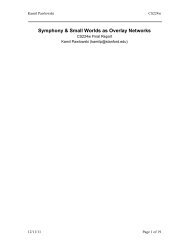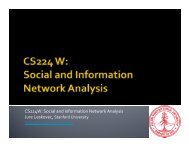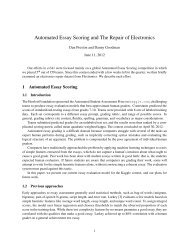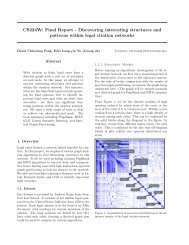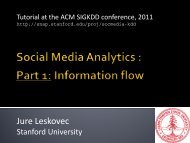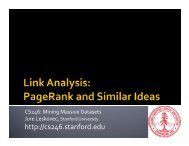Exploiting Longer Cycles for Link Prediction in Signed Networks
Exploiting Longer Cycles for Link Prediction in Signed Networks
Exploiting Longer Cycles for Link Prediction in Signed Networks
You also want an ePaper? Increase the reach of your titles
YUMPU automatically turns print PDFs into web optimized ePapers that Google loves.
Table 2: Accuracy of HOC Methods<br />
Ep<strong>in</strong>ions Slashdot Wikipedia<br />
HOC-3 0.9014 0.8303 0.8424<br />
HOC-5 0.9080 0.8469 0.8605<br />
Table 3: False Positive Rate of HOC Methods<br />
Ep<strong>in</strong>ions Slashdot Wikipedia<br />
HOC-3 0.4756 0.5575 0.5488<br />
HOC-5 0.4441 0.5070 0.4817<br />
edu). All the networks have explicit sign labels on the l<strong>in</strong>ks.<br />
Refer to Table 1 <strong>for</strong> the statistics of the networks. Note that<br />
MOI-3 is normalized by the total number of triangles. Refer<br />
to [6] <strong>for</strong> description of the networks. We have 2 families of<br />
methods: one based on measures of imbalance (MOI) from<br />
Section 4 and the other based on the supervised mach<strong>in</strong>e<br />
learn<strong>in</strong>g approach <strong>in</strong>volv<strong>in</strong>g higher order cycles (HOC) described<br />
<strong>in</strong> Section 5. Both families depend on a parameter<br />
k ≥ 3 that denotes the order of the cycles that the method<br />
is based on. For MOI, we consider k up to 10 and <strong>for</strong> HOC<br />
we consider k = 3, 4,5. Note that the set of features used<br />
by HOC-(k + 1) is a strict superset of the features used by<br />
HOC-k. We also rem<strong>in</strong>d the reader that MOI-3 and HOC-3<br />
are the methods considered <strong>in</strong> [6].<br />
We evaluate and compare MOI methods us<strong>in</strong>g a leaveone-out<br />
type methodology: each edge <strong>in</strong> the network is successively<br />
removed and the method tries to predict the sign<br />
of that edge us<strong>in</strong>g the rest of the network. For HOC methods,<br />
we resort to 10-fold cross-validation. We (randomly)<br />
created 10 disjo<strong>in</strong>t test folds each consist<strong>in</strong>g of 10% of the<br />
total number of edges <strong>in</strong> the network. For each test fold, the<br />
rema<strong>in</strong><strong>in</strong>g 90% of the edges serve as the tra<strong>in</strong><strong>in</strong>g set. For<br />
a given test fold, the feature extraction and logistic model<br />
tra<strong>in</strong><strong>in</strong>g happens on a graph with the test edges removed.<br />
We report accuracies and false-positive rates by averag<strong>in</strong>g<br />
them over the 10 folds.<br />
6.1 Results<br />
Our experiments on the three onl<strong>in</strong>e social networks show<br />
that higher order cycles benefit the accuracy of sign prediction<br />
and lower the false positive rate. Furthermore, the<br />
results are consistent across the three diverse networks. Figure<br />
2 shows the accuracy of MOI based methods. Note<br />
that the accuracy is shown <strong>for</strong> edges with embeddedness<br />
under certa<strong>in</strong> threshold. Firstly, we see that accuracy is<br />
non-decreas<strong>in</strong>g <strong>in</strong> embeddedness threshold. Next, it is clear<br />
that higher-order methods per<strong>for</strong>m significantly better than<br />
MOI-3 (triangles) method. F<strong>in</strong>ally, the per<strong>for</strong>mance boost is<br />
large <strong>for</strong> edges with low embeddedness. This is expected as<br />
edges of low embeddedness by def<strong>in</strong>ition do not have many<br />
common neighbors <strong>for</strong> their end-po<strong>in</strong>ts, and higher-order cycles<br />
have relatively better <strong>in</strong><strong>for</strong>mation <strong>for</strong> such edges than<br />
others. We also observe from our experiments that beyond<br />
k = 5, the per<strong>for</strong>mance ga<strong>in</strong> is not very significant.<br />
Figure 1 shows the distribution of edge embeddedness <strong>in</strong><br />
the data sets. Observe that a significant fraction of the edges<br />
have low embeddedness <strong>in</strong> all the networks. Thus, <strong>for</strong> a good<br />
fraction of edges, we observe a large <strong>in</strong>crease <strong>in</strong> accuracy of<br />
higher-order MOI based methods, <strong>in</strong> all the data sets.<br />
The results <strong>for</strong> the supervised HOC methods are shown<br />
<strong>in</strong> Tables 2 & 3 and Figure 3. In all the data sets, there<br />
is a small improvement <strong>in</strong> accuracy by us<strong>in</strong>g higher order<br />
cycles (HOC-5), as shown <strong>in</strong> Table 2. The false positive rate,<br />
however, reveals a more <strong>in</strong>terest<strong>in</strong>g phenomenon <strong>in</strong> Table 3.<br />
Indeed, higher order methods (such as HOC-5) significantly<br />
reduce the false positive rate as compared to that of HOC-3.<br />
However Figure 3 shows that, unlike MOI based methods,<br />
edge embeddedness does not seem to affect the decrease <strong>in</strong><br />
false positive rate <strong>for</strong> HOC methods. We see this trend<br />
across all the data sets.<br />
7. CONCLUSION<br />
We see that longer cycles significantly benefit sign prediction,<br />
and do so consistently across many real-world networks.<br />
We presented a framework to obta<strong>in</strong> a l<strong>in</strong>k prediction<br />
algorithm, us<strong>in</strong>g any quantitative measure of imbalance.<br />
Higher order cycles came as a natural generalization of local<br />
triangles, and furthermore, the generalization is wellfounded<br />
by the general theory of social balance. F<strong>in</strong>ally,<br />
we observe that the edges appear<strong>in</strong>g <strong>in</strong> real-world signed<br />
networks do not necessarily con<strong>for</strong>m to the <strong>in</strong>tuitions underly<strong>in</strong>g<br />
the social balance theory, and longer cycles conta<strong>in</strong><br />
more useful <strong>in</strong><strong>for</strong>mation <strong>for</strong> predict<strong>in</strong>g edge signs.<br />
8. ACKNOWLEDGMENTS<br />
This research was supported by NSF grant CCF-0916309<br />
and DOD Army grant W911NF-10-1-0529.<br />
9. REFERENCES<br />
[1] D. Cartwright and F. Harary. Structure balance: A<br />
generalization of Heider’s theory. Psychological<br />
Review, 63(5):277–293, 1956.<br />
[2] D. Easley and J. Kle<strong>in</strong>berg. <strong>Networks</strong>, Crowds, and<br />
Markets. Cambridge University Press, 2010.<br />
[3] R. Guha, R. Kumar, P. Raghavan, and A. Tomk<strong>in</strong>s.<br />
Propagation of trust and distrust. In WWW, pages<br />
403–412, 2004.<br />
[4] F. Harary. On the notion of balance of a signed graph.<br />
Michigan Mathematical Journal, 2(2):143–146, 1953.<br />
[5] J. Kunegis, S. Schmidt, A. Lommatzsch, J. Lerner,<br />
E. W. D. Luca, and S. Albayrak. Spectral analysis of<br />
signed graphs <strong>for</strong> cluster<strong>in</strong>g, prediction and<br />
visualization. In SDM, pages 559–570, 2010.<br />
[6] J. Leskovec, D. Huttenlocher, and J. Kle<strong>in</strong>berg.<br />
Predict<strong>in</strong>g positive and negative l<strong>in</strong>ks <strong>in</strong> onl<strong>in</strong>e social<br />
networks. In WWW, pages 641–650, 2010.<br />
[7] J. Leskovec, D. Huttenlocher, and J. Kle<strong>in</strong>berg. <strong>Signed</strong><br />
networks <strong>in</strong> social media. In CHI, pages 1361–1370,<br />
2010.<br />
[8] D. Liben-Nowell and J. Kle<strong>in</strong>berg. The l<strong>in</strong>k-prediction<br />
problem <strong>for</strong> social networks. Journal of the American<br />
Society <strong>for</strong> In<strong>for</strong>mation Science and Technology,<br />
58(7):1019–1031, 2007.<br />
[9] Z. Lu, B. Savas, W. Tang, and I. S. Dhillon.<br />
Supervised l<strong>in</strong>k prediction us<strong>in</strong>g multiple sources. In<br />
ICDM, pages 923–928, 2010.<br />
[10] A. van de Rijt. The micro-macro l<strong>in</strong>k <strong>for</strong> the theory of<br />
structural balance. Journal of Mathematical Sociology,<br />
35(1):94–113, 2011.



